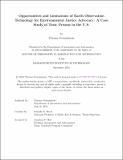Opportunities and Limitations of Earth Observation Technology for Environmental Justice Advocacy: A Case Study of Toxic Prisons in the U.S.
Author(s)
Ovienmhada, Ufuoma
DownloadThesis PDF (30.35Mb)
Advisor
Wood, Danielle R.
Terms of use
Metadata
Show full item recordAbstract
People of color and other socio-economically marginalized groups in the United States experience a disproportionate burden of environmental challenges such as air pollution and extreme heat; the Environmental Justice (EJ) movement aims to combat these burdens and promote collective well being. Earth Observation (EO) technology, such as satellites, can be used to monitor air quality, extreme heat, and other quantities relevant to EJ. However the application of this technology in measuring EJ, or supporting EJ advocacy efforts has not been widely explored. Satellite EO systems also historically have not been designed with EJ end users in mind. This application is increasingly more pressing as space agencies like NASA are seeking information on how their data can be used to support underserved communities. This dissertation brings together EO data science, systems engineering, and community- engagement to elucidate opportunities and limitations of Earth Observation Technology for Environmental Justice Advocacy. The dissertation is organized into three categories of contributions – Description, Evaluation, and Design/Prescription – that are each composed of multiple research efforts.
In Description, I apply a three-pronged approach to provide insights on the opportunities and limitations of EO data for EJ. First, along with a team of researchers, I assess peer- reviewed literature on satellite data for environmental justice through a scoping review. The second contribution of this chapter is an interview study with a subset of grassroots EJ actors about how they can use EO data in their domain of EJ activism which contests the exposure of prisons and incarcerated people to environmental hazards. The third contribution of this chapter is a system’s engineering architectural description of NASA’s current satellite EO for EJ ecosystem. Using justice theory as an analytical framework, I reveal limitations of NASA’s current EO for EJ architecture for advancing holistic notions of EJ.
In Evaluation, with support from co-authors, I measure spatiotemporal patterns of air pollution burden, and air and land surface temperature extremes in prison landscapes across the U.S. These studies contribute to a nascent literature documenting empirical evidence of environmental hazards in carceral landscapes. It also extends the literature on applications of satellite-derived and modeled geospatial data for EJ. In Design/Prescription, first, supported by 3 years of community engagement with prison EJ activists, I present the Design of a GIS decision support system that features EO data responding to expressed needs of prison EJ activists. Then, I present two essays that Prescribe recommendations for methodological innovations in the design and application of EO technologies and geospatial data for EJ advocacy.
Together, these three chapters demonstrate the immediate relevance of EO and geospatial technologies for prison EJ advocacy, and broader implications for the EO community interested in supporting the aims of the EJ movement more holistically.
Date issued
2024-09Department
Massachusetts Institute of Technology. Department of Aeronautics and AstronauticsPublisher
Massachusetts Institute of Technology